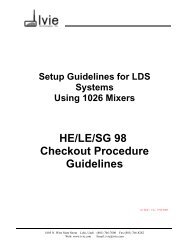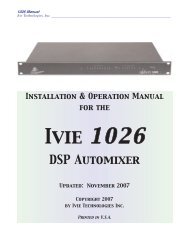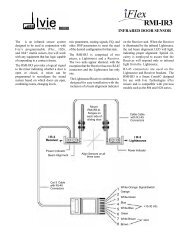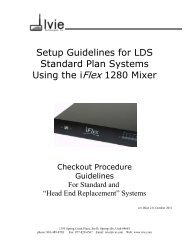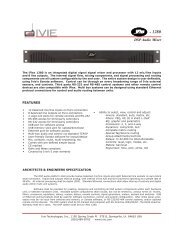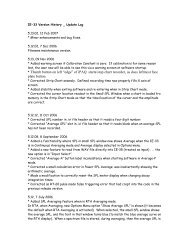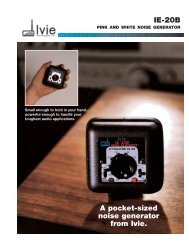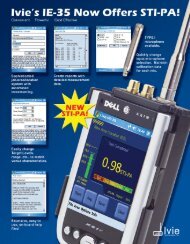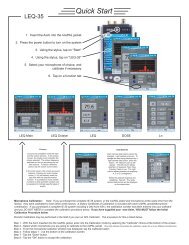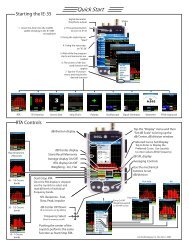Create successful ePaper yourself
Turn your PDF publications into a flip-book with our unique Google optimized e-Paper software.
<strong>IE</strong>-<strong>33</strong> Controls<br />
Introduction<br />
page 6<br />
<strong>Ivie</strong> <strong>IE</strong>-<strong>33</strong> & <strong>IE</strong>-<strong>35</strong> <strong>Manual</strong><br />
Congratulations! With your purchase of the <strong>Ivie</strong> <strong>IE</strong>-<strong>33</strong>, or <strong>IE</strong>-<strong>35</strong>, you not only have one of the most powerful, versatile,<br />
and accurate audio spectrum analyzers available, but you also have an analysis system that is capable of<br />
expanding as your needs expand. The supplied microphone is a Type II microphone, making the standard <strong>IE</strong>-<strong>33</strong>,<br />
or <strong>IE</strong>-<strong>35</strong>, a Type II measurement system. For those needing Type I accuracy, an optional microphone, preamplifier<br />
and extension cable is available to convert either analyzer to a Type I measurement system. With reasonable<br />
care, the <strong>IE</strong>-<strong>33</strong> and <strong>IE</strong>-<strong>35</strong> will provide a long period of useful service.<br />
This manual is intended to familiarize you with the basic operations of the <strong>IE</strong>-<strong>33</strong> and <strong>IE</strong>-<strong>35</strong>, and to whet your<br />
appetite concerning some of its possibilities. It is in no way intended to be the total description of all the possibilities<br />
of these units.<br />
The <strong>IE</strong>-<strong>33</strong> software runs on the HP© iPAQ© and requires an iPAQ 3950, or later jacket compatible model. (See<br />
the <strong>IE</strong>-<strong>33</strong> FAQ at www.ivie.com for a complete list of compatible iPAQ models). Pocket PC 2003 OS is required<br />
and ActiveSync software Version 3.7.1 or later. The <strong>IE</strong>-<strong>35</strong> software runs on the Dell® Axim® X50 or later model.<br />
(The <strong>IE</strong>-<strong>35</strong> is shipped with the Dell® Axim® X51v). Pocket PC 2005 is required and ActiveSync software Version<br />
4.0, or later.<br />
*******NOTICE!! <strong>IE</strong>-<strong>33</strong> POTENTIAL DATA LOSS!!*******<br />
The iPAQ, like all PDA’s runs on battery power. HP® is clear in their warnings about data loss if the battery is<br />
completely run down. If you run the battery all the way down, your data can and will be lost! (This has a much<br />
harsher sound if you’ve just completed a couple of days of taking measurements when the data goes bye bye!).<br />
To guard against accidental data loss, a backup utility is included in the iPAQ software suite. This utility is easy<br />
to use. You can schedule regular (even daily) backups that will happen automatically, or you can start backups<br />
manually. The Sprite Backup utility included with the iPAQ will back up to the “iPAQ File Store” (an 8 MB non<br />
volatile storage area in the iPAQ itself), or to an SD-style memory card that plugs into the iPAQ’s SD card slot.<br />
Sprite also makes a separate backup utility which can be used to back up your iPAQ to the hard drive of your<br />
PC. We recommend that you make provision for backing up your <strong>IE</strong>-<strong>33</strong> data on a regular basis.<br />
The <strong>IE</strong>-<strong>35</strong> does not have this concern. It is based on the Dell® Axim® X51v which features “Retentive<br />
Memory.” The <strong>IE</strong>-<strong>35</strong> will not lose data, even if the battery is accidentally run down.<br />
<strong>IE</strong>-<strong>33</strong> Controls (<strong>IE</strong>-<strong>35</strong> Controls are Further Detailed on Pages 8 & 9)<br />
As demonstrated across the page, the <strong>IE</strong>-<strong>33</strong> makes use of a number of different controls, both software and<br />
hardware based. The controls can be divided into three categories: 1) Hardware Buttons, 2) Software Defined<br />
Stylus Buttons and 3) Pop-up Menus. Like the stylus buttons, the pop-up menus are activated using the stylus.<br />
Hardware Buttons (<strong>IE</strong>-<strong>33</strong>)<br />
The <strong>IE</strong>-<strong>33</strong> software defines the use of the iPAQ hardware buttons as shown across the page. The thumb button,<br />
for example, can be used to take a memory "snapshot" when in the RTA mode. It is also used to pause or<br />
resume taking samples when in the Average Continuous mode and to "add a single sample" when in the Memory<br />
Trigger mode. These features are covered in detail in the section of this manual dealing with memory functions.<br />
Stylus Buttons (<strong>IE</strong>-<strong>33</strong>)<br />
The stylus buttons contain many of the most used features of the <strong>IE</strong>-<strong>33</strong>. They are clearly labeled and very intuitive.<br />
Some duplicate the function of hardware buttons, as in the Zoom In and Zoom Out functions, as shown in<br />
the illustration on page 3. The stylus buttons allow selection of the RTA display in octave, one third octave,



